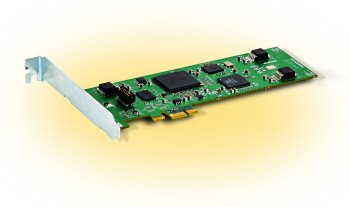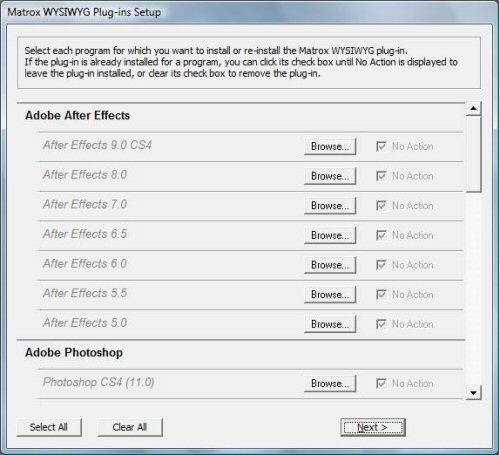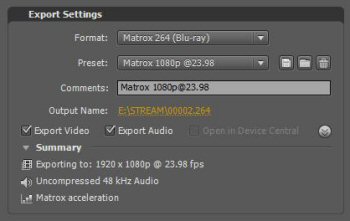

Model: Matrox CompressHD H.264 Encoding Accelerator Card
Manufacturer: Matrox
Provided By: Matrox
Matrox is no stranger to the computer industry. Founded more than 30 years ago, this Canadian company is recognized as a leading manufacturer of professional graphics solutions. While best known for their high-end graphics cards, Matrox also has groups involved in developing imaging solutions as well as providing digital video editing products for broadcast and video professional markets.
While MPEG-2 was the de facto video standard for many years, the growing demand for high-def content has resulted in a number of new formats. One of the more promising developments is the H.264 standard. Utilizing the latest video compression technology, H.264 delivers the same quality as MPEG-2 at a third to half the bit rate. This allows you to create much smaller video files which require less network bandwidth and storage space.
 There is one down-side to the H.264 standard and that's that it's very resource intensive. Even with a high-end computer, it can take a considerable amount of time to encode HD video with even a moderate bit rate. To speed things up, Matrox developed its Matrox MAX technology. This unique technology uses a dedicated hardware processor which can encode an H.264 file for mobile devices, the web or even Blu-ray Discs in less than real time.
There is one down-side to the H.264 standard and that's that it's very resource intensive. Even with a high-end computer, it can take a considerable amount of time to encode HD video with even a moderate bit rate. To speed things up, Matrox developed its Matrox MAX technology. This unique technology uses a dedicated hardware processor which can encode an H.264 file for mobile devices, the web or even Blu-ray Discs in less than real time.
One of the first products to support Matrox MAX is the CompressHD. This low profile, half-length PCI Express card works in systems with or without a video I/O device. Using applications such as Apple Compressor on the Mac and Adobe Media Encoder on the PC, the CompressHD is able to encode H.264 files at resolutions ranging from iPod to HD and at bit rates as high as 50MB/s.
While it took a little longer than expected, Matrox has finally shipped the PC drivers for the CompressHD. In this review, we'll take a closer look at Matrox's H.264 encoding accelerator card and then see how well it performs.
The CompressHD comes in a small, yellow and white box with a picture of the card on the front and back. Surprisingly, there is very little information about the CompressHD's capabilities.

Inside the box, you'll find the card, some warranty and service information, and a sheet of paper listing some basic installation instructions as well as a web address where you can download the latest version of the CompressHD software and documentation.
Physical Features:
Considering its capabilities, the CompressHD looks very unassuming. This low profile, half-length PCIe x1 card doesn't have a heat sink or fan and should fit easily inside most computer cases.


Here's a closer look at the brains behind the CompressHD. The XILINX Spartan-3A (XC3SD1800A) DSP delivers 21 GMAC/s (billion multiply accumulate operations per second) and up to 1,736 Mbps of memory bandwidth. If that weren't enough, the CompressHD also has a dedicated H.264 encoder in the form of the Ambarella A2-A1-RH A288S SoC.

Installing the CompressHD is pretty straightforward. To begin, shut down your system, unplug the power cord and open your computer’s case. Next, insert the Matrox CompressHD card in an available PCIe slot and secure it into place. Once that is done, close your computer’s case, reconnect the power cord and turn the system back on.
Before you install Matrox Mtx.utils, you'll want to make sure that Adobe Media Encoder is installed on your computer. It is included with many Adobe programs, such as Adobe Premiere Pro, After Effects and Encore. In my case, I already had Adobe Creative Suite 4 installed on my computer.
Matrox Mtx.utils installs the CompressHD device driver and all the software required to use the card with Adobe Media Encoder. This includes presets for using Adobe Media Encoder to export material to various formats with the Matrox MAX H.264 codec. The Matrox Video for Windows (VFW) software codecs are also installed so that you can play back Matrox .avi files on your CompressHD system.

Matrox Mtx.utils also installs software for the Matrox MXO2. If your computer doesn't have one of these I/O devices, you won't be able to use the A/V Tools, the WYSIWYG plug-ins or the HDMI Monitor Calibration Program.

Once the software is installed, Matrox Mtx.utils will install the driver for the CompressHD and, if necessary, update its firmware.



When you're done, you'll see two new formats listed in Adobe Media Encoder. The Matrox 264 (Blu-ray) format creates a .264 elementary stream file, which is supported for Blu-ray Disc authoring. Audio is exported as separate mono or stereo .wav files (PCM audio). The Matrox MP4 format creates an .mp4 file with embedded AAC audio, which is suitable for the web and mobile devices.
|
|
|
Both formats include a number of preset configurations. You can also create your own custom configurations by selecting the frame size, frame rate and aspect ratio of the video as well as the sample rates and bit rate of the audio. The Matrox MAX H.264 codec can be tweaked even further by specifying the H.264 level, compression algorithm, data rate and GOP structure.

The most important setting here is the data rate or bit rate. The higher the data rate you select, the better the video quality will be. Take note that the PC drivers only support constant bit rate (CBR) encoding and a maximum data rate of 20MB/s. This is a bit disappointing as the CompressHD has a maximum data rate of 50MB/s when installed in a Mac. According to sources at Matrox, the CompressHD will support a higher data rate on the PC in a future driver release.
The test system used in this review was an Dell Optiplex 960 with 64-bit Windows Vista installed on it. The computer came equipped with an Intel Core 2 Quad Q9550 2.83GHz CPU, 8GB of DDR2 800MHz memory, Seagate Barracuda 7200.10 ST3250310AS 250GB SATA hard drive and ATI Radeon HD 3470 PCIe graphics card.
To test the performance of the Matrox CompressHD, I first encoded a two hour 1080p .m2ts video file using the H.264 and Matrox MP4 formats in Adobe Media Encoder. Where the H.264 format uses the system's CPU to encode video, Matrox MP4 takes full advantage of the CompressHD's processing power. To make this more of an apples to apples comparison, I created two custom configurations with a resolution of 1920x1080, frame rate of 23.97 fps and constant bit rate of 15MB/s. In both cases, I used embedded AAC audio with a 48kHz sample rate and 128 kpbs bit rate.
I also encoded a 480p MPEG-2 video file that was 37:36 in length. I created two custom configurations for the H.264 and Matrox MP4 formats with a resolution of 720x480, frame rate of 29.97 fps and constant bit rate of 3MB/s. Here too, I used embedded AAC audio with a 48kHz sample rate and 128 kpbs bit rate.

The graph above pretty much speaks for itself. Where it took nearly seven hours to encode a two hour 1080p video using the CPU alone, the CompressHD was able to do it in less than two. The card also reduced the amount of time it took to encode our 480p test video from 28:25 down to a little more than 12 minutes.
While I've always found video quality to be a bit subjective, I took a few screenshots to compare the results from the H.264 and Matrox MP4 formats. To view them in full size, click the images below.
While there are a few slight variations in regards to brightness and color, the quality of the video produced by the H.264 and Matrox MP4 formats were quite good.
Final Thoughts:
With a suggested retail price of $495, the Matrox CompressHD is not for the average consumer. The card is a great investment, though, for the professional that does a lot of H.264 encoding. With its ability to encode HD video in less than realtime, the CompressHD will quickly justify its cost in the amount of time saved. The Matrox MAX H.264 codec is also flexible enough to output video in formats suitable for Blu-ray Disc authoring as well as the web and mobile devices. Most importantly, the video created by the CompressHD is on par with what Adobe Media Creator can output using its own H.264 codec.
That being said, the Matrox CompressHD isn't perfect. The Matrox MAX H.264 codec only works with a few applications. If you're using something other than Apple Compressor or Adobe Media Encoder, you won't be able to take advantage of the CompressHD's processing power. Also, the codec only does constant bit rate encoding and, for whatever reason, the bit rate is limited to 20MB/s on the PC. While the lack of variable bit rate support won't be a deal breaker for most, PC users looking to encode Blu-ray Disc movies at the highest possible bit rate may want to wait and see if Matrox addresses this a future software update.
The Matrox CompressHD is available now and can be purchased from Amazon.com or from one of the vendors listed on Pricegrabber for $495.
Highs:
- Faster than realtime H.264 encoding
- Supports resolutions ranging from iPod to HD
- Low profile, half-length PCIe card
- Supports bit rates up to 50MB/s on the Mac
- Quiet
Lows:
- Expensive
- Limited software support
- Cannot do variable bit rate encoding
- Bit rate limited to 20MB/s on the PC







